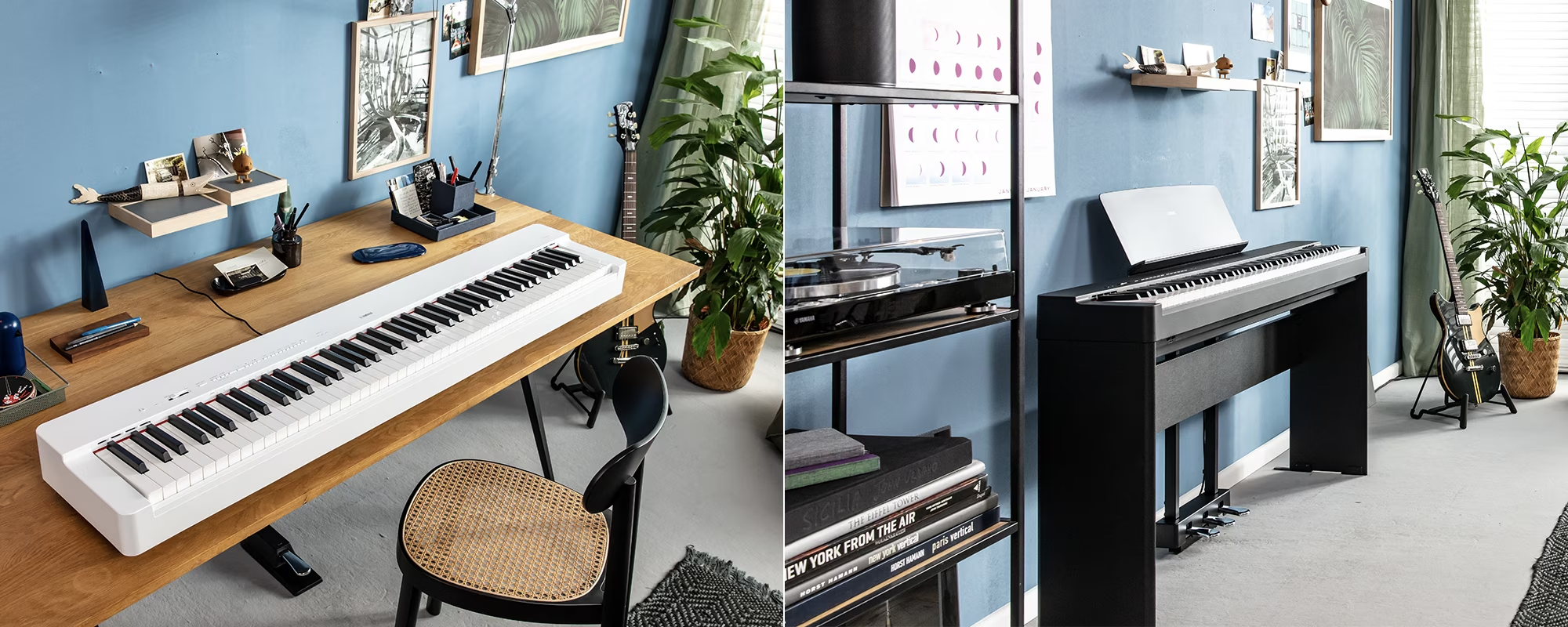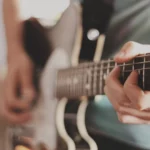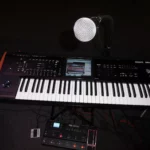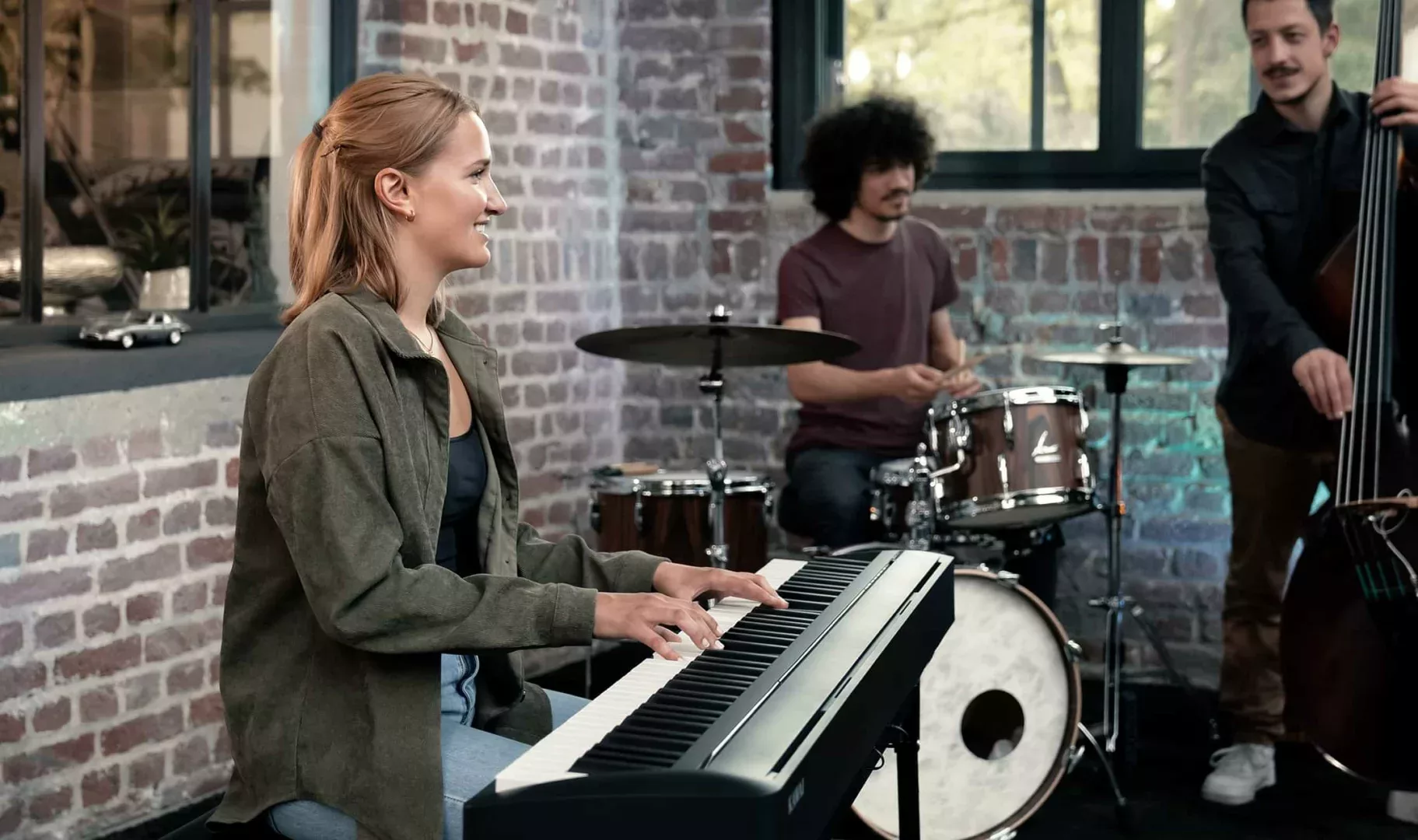
Welcome to our comprehensive guide to the best Kawai digital pianos. As a musician, you know how important it is to have the best instrument at your fingertips and Kawai pianos are known for their exceptional quality and craftsmanship.
In this guide, we’ll take a closer look at what makes Kawai digital pianos so special, explore their various models, delve into their innovative features and technology, and help you choose the right Kawai digital piano for you!
The Best Kawai Digital Pianos: Expert Piano Reviews
Contents
Kawai ES Series
Kawai ES110

Key Features
- Kawai EX concert grand piano sounds, full 88-key sampling
- 19 sounds, Dual & Split playing modes, 100 drum rhythms
- Dedicated stereo Line Out jacks
- Integrated Bluetooth 4.0 wireless technology
- Built-in classical etudes and Alfred lesson books
- Ultra-portable and sturdy chassis, weighing just 26 pounds (12 KG)
- Designer stand and triple pedal board accessories available
The Kawai ES110 is a digital piano that impresses with its authentic piano feel and sound quality, making it one of the best digital pianos for beginners. The Responsive Hammer Compact (RHC) keyboard technology offers a natural and responsive touch.
The 88 keys are weighted to provide a graded hammer action, ensuring a dynamic playing experience across the entire keyboard.
One standout feature of the ES110 is its rich and expressive piano sound, thanks to Kawai’s Harmonic Imaging technology. The instrument provides a selection of high-quality instrument voices, and its 14 watt speakers deliver a clear and rich sound.
Additionally, the built-in dual headphone jacks make it convenient for silent practice or duets. Its compact and lightweight design enhances portability, making it an excellent choice for musicians on the go.
The ES110 directly competes with other beginner digital pianos such as the Roland FP10 and the Yamaha P45. There is also a dedicated Carry Case for the ES110, though others are also available:

Kawai ES110 vs Yamaha P125
These Yamah P125 offers similar specifications to the ES110, and the choice would be down to personal preference. They both offer 192 note polyphony allowing for complex musical passages, weighted and graded keyboard actions, and USB connectivity.
Kawai ES110 vs Kawai ES120
The ES120 is a newer iteration of the ES110 and offers some improvements such as an improved action, new sounds, and Bluetooth MIDI and Audio connectivity.
Kawai ES110 vs Roland FP30X
The Roland FP30X edges ahead of the Kawai ES110 with enhanced polyphony, which is how many notes the instrument can sustain at once, and is also useful when combining sounds together. It also offers wireless Bluetooth connectivity.
FP30X features:
- Keyboard Action: PHA-4 Standard with progressive hammer action for a realistic feel.
- Sound Engine: SuperNATURAL Piano sound engine for authentic piano tones.
- Polyphony: 256 notes, providing ample room for intricate playing.
- Special Features: Bluetooth connectivity, a wide range of sounds, Twin Piano mode for side-by-side lessons.
Kawai ES120
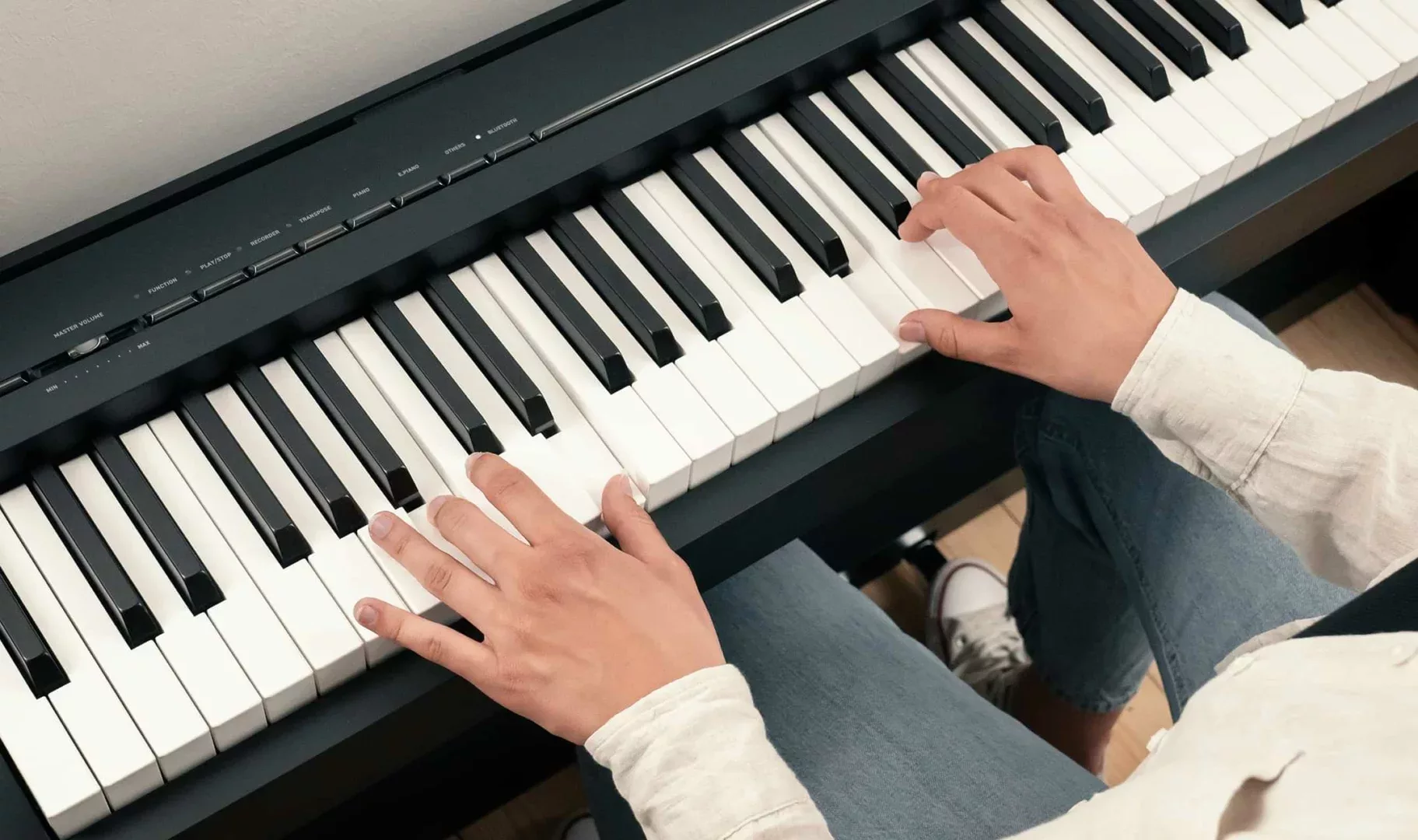
Key Features
- Improved Responsive Hammer Compact keyboard action
- SK-EX and EX concert grand piano sounds, 88-key sampling
- 25 sounds, Dual & Split playing modes, 100 drum rhythms
- Dual headphone connectors, dedicated stereo Line Out jacks
The ES120 is a recent release from Kawai (2022) and an upgrade to the ES110. It is another digital piano that is suitable for beginner to intermediate pianists.
Action
It features an improved Responsive Hammer Compact keyboard action, beautiful Shigeru Kawai grand piano sounds, and built-in Bluetooth® MIDI and Audio connectivity.
The action features spring-less technology that delivers consistent upward and downward motion, while improved cushioning material helps to reduce keyboard noise, resulting in a smooth, natural, and highly authentic piano playing experience.
Sound
The instrument features two excellent piano sounds, Kawai’s flagship Shigeru Kawai SK-EX concert grand piano, and their highly acclaimed EX concert grand piano.
There are a variety of other tones included as you would expect, including electric pianos, organs, and more. These sounds are og a high-quality and are very usable for live performances, with some interesting and unique EP’s onboard.
Kawai ES120 vs Roland FP30X
Again, the choice here would be down to personal taste, and it is recommended to try both in store if you can, as piano/keyboard action preferences are personal. The PHA IV action in the FP30X is arguably better, but you may also prefer the sound of the Kawai.
Kawai ES510

The Kawai ES510 represents a notable step forward over the ES110 and ES120, introducing several enhancements that contribute to a better piano-playing experience.
One of the standout features is the Responsive Hammer III (RHIII) keyboard action, a significant improvement over the ES110’s Responsive Hammer Compact (RHC) technology.
This advanced action system provides a more realistic and nuanced feel, replicating the touch of an acoustic piano with greater precision and sensitivity.
Sound quality is another area where the ES510 shines. Kawai’s Harmonic Imaging XL (HI-XL) sound engine delivers a rich and expressive piano tone, capturing the subtleties of each note with exceptional clarity.
The expanded selection of instrument voices further broadens the creative possibilities for musicians. The ES510 maintains dual headphone jacks for silent practice or collaborative sessions, and its portability remains a key feature for those on the move.
In terms of connectivity, the ES510 introduces Bluetooth MIDI functionality, allowing seamless integration with smart devices for a more versatile and modern playing experience. The control panel has also been fully redesigned.
Kawai ES520 vs Kawai ES920
The ES920 is a more advanced model with several enhancements. The main improvements are to the keyboard action and the addition of more sounds.
Kawai ES520 vs Roland FP60X
The Roland FP-60X offers a more advanced keyboard action (PHA-50), a variety of sound customization options, and additional connectivity features, making it a more versatile option for musicians who want a broader range of capabilities.
However, the choice between them would still depend on specific preferences regarding touch, features, and intended use. It is advisable to try both in store if you can, before purchasing.
Kawai ES920

The ES920 is the flagship instrument in Kawai’s ES range of digital pianos.
Key Features
- Harmonic Imaging XL sound engine with 88-key sampling
- Integrated Bluetooth® MIDI and Audio wireless technology
- MP3/WAV playback, record, and overdub to USB memory
- 4-band EQ faders, Rhythm Section accompaniment with 100 styles
- Spatial Headphone Sound for enhanced depth and realism
- Modern, lightweight case with matching stand and triple pedal unit available
Action
One of the standout improvements is the implementation of the Responsive Hammer III (RHIII) with let-off and triple-sensors.
This action recreates the supreme touch of an acoustic grand piano accurately, with its realistic movement and rigid, springless design. It also introduces let-off simulation, mimicking the feel of a grand piano and surpassing the key action of the ES520.
The instrument’s triple-sensor hammer detection system enhances responsiveness and accuracy, while structural reinforcements throughout the action assembly help to minimize noise and key wobble during staccato and fortissimo passages.
The weight of the keyboard is also appropriately graded to mirror the heavier bass hammers and lighter treble hammers of an acoustic piano, while let-off simulation recreates the subtle ‘notch’ sensation felt when softly playing the keys of a grand piano.
Sound
The ES920 captures the magnificent tone of two Shigeru Kawai instruments, the flagship SK-EX Concert, and medium-sized SK-5 Studio grand pianos, allowing musicians to enjoy the contrasting properties of each.
In addition, the ES920 also features the distinctive sound of Kawai’s highly acclaimed EX concert grand piano. All three instruments are faithfully reproduced with full 88-key sampling using proprietary Harmonic Imaging™ sound technology.
The ES920 features a redesigned motherboard, amplifier, and audio delivery system. These premium components combine to deliver best-in-class audio quality, producing an extremely rich, clear sound with minimal distortion.
The ES920’s impressive 40W output system utilizes speaker box enclosures that deliver a rich, expansive sound to rival much larger console digital pianos. This design allows the Es920 to be used for small and medium-sized performances without an amp.
Kawai ES920 vs ES520
In terms of sound quality, the ES920 boasts the Harmonic Imaging XL (HI-XL) sound engine, delivering a more expansive and dynamic piano tone compared to the ES520.
Connectivity has also been significantly upgraded in the ES920, featuring Bluetooth MIDI capabilities for wireless communication with smart devices.
The redesigned control panel and improved user interface contribute to a more intuitive and user-friendly navigation experience.
Overall, the Kawai ES920 stands as a superior successor to the ES520, delivering enhanced keyboard action, superior sound quality, and modern connectivity features, whilst remaining portable and at a reasonable weight – 55 pounds (25 kg).
A dedicated Kawai stand is available for both the ES520 and ES920.

Kawai Stage Pianos
Kawai MP7SE

The Kawai MP7SE is a professional-grade stage piano that combines advanced features with an authentic playing experience, making it an excellent choice for both stage performers and studio musicians.
Action
One of its standout features is the Responsive Hammer III (RHIII) keyboard action, which replicates the feel of an acoustic grand piano.
The graded hammer action and triple sensor system contribute to a highly responsive and nuanced playing experience, allowing for expressive performances across the entire keyboard.
Sound
In terms of sound, the MP7SE boasts the Harmonic Imaging XL (HI-XL) sound engine, delivering a rich and dynamic range of high-quality instrument sounds.
It includes a vast selection of acoustic piano tones, electric pianos, and a variety of other instrument sounds, providing versatility for a wide range of musical genres.
Another standout feature is the Virtual Technician feature that allows users to customize and fine-tune various aspects of the sound, tailoring it to individual preferences.
Connections and Controls
The MP7SE excels in connectivity options, featuring a comprehensive array of ports, including USB, MIDI, and audio outputs. It also supports Bluetooth MIDI for seamless wireless connectivity with smart devices and computers.
The user interface can be a little dated with menu diving and a small screen, but the overall playing experience outweighs this minor issue.
Overall
The Kawai MP7SE is not a lightweight stage piano like a Nord stage 4 or Nord Electro 6D, as it weighs 46 pounds. It also on the expensive side at over $2000 dollars (at the time of writing). You may find some good deals on a used model on eBay or reverb.
Find out more about the Mp7SE on the Kawai Product Page where you will also find the dedicated Case.
Kawai MP11SE
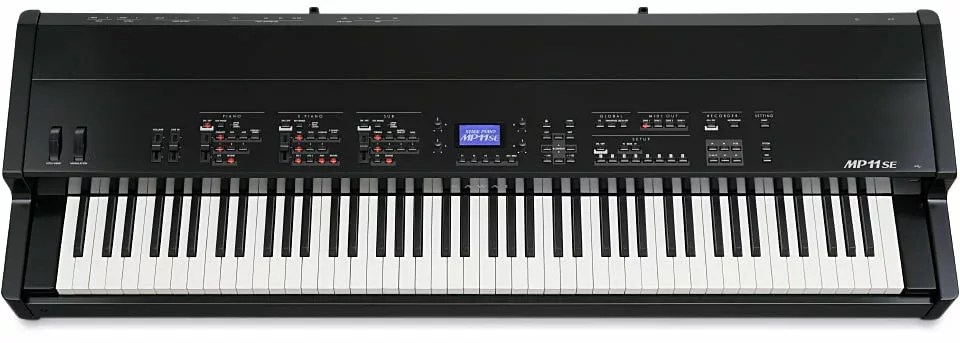
The Kawai MP11SE is a flagship digital stage piano that caters to the demands of professional pianists and discerning musicians who seek a premium playing experience.
Action
At the heart of its impressive performance is the Grand Feel wooden-key keyboard action, an exceptional keybed that emulates the feel of a grand piano.
This mechanism, combined with Ivory and Ebony Touch key surfaces, provides an authentic touch that enables nuanced and expressive playing.
Sound
Sound quality on the MP11SE is driven by the Harmonic Imaging XL (HI-XL) sound engine, delivering an unparalleled level of realism.
The instrument offers a comprehensive range of high-quality instrument sounds, with a particular emphasis on its stunning acoustic piano tones.
The Virtual Technician feature allows for in-depth customization, enabling players to fine-tune various aspects of the sound to their liking.
Connectivity and Controls
Connectivity is another strong suit of the MP11SE, featuring a variety of ports such as USB, MIDI, and audio outputs. Its USB audio capabilities make it a versatile tool for recording and integration with computer-based setups.
The instrument’s control panel is intelligently designed, offering intuitive access to functions and making it easy for users to navigate the extensive feature set.
Overall
The MP11SE is housed in a robust and elegant cabinet, conveying a sense of quality and durability. It is a professional-grade stage piano that excels not only in its authentic piano playing experience but also in its versatility.
While it may be on the heavier side, the weight is a testament to the instrument’s robust build and quality components.
Kawai MP11SE vs Roland RD2000
The choice here would be down to personal preference, and also what used options there are in your area!
Kawai VPC1

The Kawai VPC1 is a MIDI controller and not a digital piano, but still deserves its place in the Kawai stage piano category. To be clear, it has no internal sounds, and requires a connection to software.
It is designed to deliver an exceptional piano playing experience for professional pianists. The VPC1 features Kawai’s renowned wooden-key “Grand Feel” keyboard action, which accurately replicates the touch of a grand piano.
The keys have a realistic weight and responsiveness, allowing for a nuanced and expressive performance. The graded hammer action, combined with triple sensor technology, ensures a lifelike piano playing experience across the entire keyboard.
The absence of internal sounds might limit its standalone functionality, but it excels when paired with high-quality virtual piano software on a computer. The VPC1 is a favorite among professional pianists and studio musicians.
Built with quality materials, the VPC1 exudes durability and sturdiness. It provides a standard set of features including pedal inputs, USB connectivity, and MIDI ports.
Delivering an unparalleled playing experience, it is an ideal choice for those seeking a top-tier MIDI controller. Find out more about the Kawai VPC1 on the Kawai Product Page.
FAQ
1. Are Kawai Pianos Good?
- Kawai Pianos offer exceptional quality and craftsmanship.
- There are various models and series to fit the different skill levels of pianists.
- Kawai Pianos incorporate innovative features and technology for outstanding performance.
- Kawai pianos are used by renowned musicians and recording studios in the professional music industry.

Acoustic Kawai pianos are the favored choice of a large number of classical pianists. Jazz pianists on the other hand, often prefer a brighter sound that cuts through a mix, so they may prefer Yamaha or Steinway Pianos.
2. Where to Buy Kawai Pianos?
Ready to invest in a Kawai Piano? It’s important to find authorized dealers and reputable sellers to ensure you’re purchasing a genuine instrument with reliable after-sale support. Here are some options to consider:
- Authorized Kawai Dealers: These dealers are certified by Kawai and offer a wide range of models with full warranty support. You can find a list of authorized dealers on Kawai’s official website.
- Online Retailers: Many online retailers offer Kawai Pianos at competitive prices. Look for reputable sellers with positive reviews and consider additional factors like shipping, handling fees, and return policies.
- Second-hand Markets: If you’re looking for a more affordable option, consider checking online marketplaces like eBay, Reverb, or Craigslist for used Kawai Pianos. Be cautious and do your research to ensure the seller is reputable.
Ultimately, the best place to buy a Kawai Piano depends on your specific needs and preferences. Consider factors like pricing, location, reputation, and available models before making a decision.
3. When Was Kawai Established?
Kawai was founded in 1927 by Koichi Kawai, a master piano craftsman, and his partners. Kawai’s passion for excellence and dedication to creating exceptional pianos have been at the forefront of the company’s philosophy since its inception.
Today, Kawai pianos are still crafted with the same attention to detail and commitment to quality that Koichi Kawai instilled in the company over 90 years ago.
In 2018, Kawai was selected as the official piano of the Technical Grammy Award ceremony. This recognition speaks volumes about the quality and reputation of Kawai Pianos.
Many famous musicians, including Joe Yamada, Yoko Ono, and Neil Sedaka, have praised Kawai Pianos for their exceptional sound quality and performance. Kawai Pianos have also been used in major events such as the Olympics and World Expo.
4. How to Maintain and Care for Your Kawai Piano?
Proper maintenance and care are crucial for keeping your Kawai Piano in top condition and ensuring its longevity. Here are some essential tips on maintaining and caring for your prized instrument:
- Regular cleaning: Dust and dirt can accumulate on your piano, affecting its sound and performance. Use a soft, dry cloth to clean the keys and the body of your piano regularly.
- Humidity control: Kawai Pianos are sensitive to changes in humidity, which can cause damage to the instrument. Invest in a humidifier to keep the humidity levels consistent in the room where your piano is kept.
- Tuning: Tuning your piano every six months or so is critical to keep it sounding its best. Hire a professional piano tuner to ensure that the instrument is correctly tuned and that any issues are identified and fixed early on.
- Protective cover: Covering your piano with a protective cover is an effective way to prevent dust, dirt, and scratches from damaging the surface. Be sure to use a cover made specifically for pianos to avoid any damage to the instrument.
- Avoid exposure to direct sunlight: Direct sunlight can cause the finish of your piano to fade or crack. Keep your piano away from windows or other areas where it may be exposed to direct sunlight.
By following these simple tips, you can keep your Kawai Piano in optimal condition and ensure that it continues to provide you with beautiful music for years to come!
5. What Are the Benefits of Owning a Kawai Piano
Investing in a Kawai Piano comes with a range of benefits that make it a worthwhile purchase for any musician. Here are some of the advantages you can expect:
- Durability: Kawai Pianos are built to last with high-quality materials and rigorous quality control processes.
- Resale Value: Should you decide to sell your Kawai Piano in the future, you can expect a good resale value due to the brand’s reputation for excellence.
- Advanced Technology: Kawai Pianos incorporate innovative technology and features that enhance their performance and sound quality.
- Exceptional Sound: Kawai Pianos are renowned for their rich and resonant sound, contributing to their popularity with musicians worldwide.
- Customization: Kawai offers a range of customization options, allowing you to personalize your piano to your specific preferences and needs.
6. How Can I Maintain and Care For My Kawai Piano?
Proper maintenance and care are essential for the longevity of your Kawai Piano. Regularly clean the keys and keep the instrument away from direct sunlight and extreme temperatures.
To learn more about Kawai digital pianos, check out the Kawai Website, or the Kawai Wiki Page.
Conclusion
Kawai Pianos are world-renowned for their exceptional quality, craftsmanship, and advanced technology. They are known for their rich, warm sound and realistic touch, which have earned them a reputation as some of the best pianos in the world.
Whether you’re a beginner searching for your first piano or a professional musician looking for the perfect instrument, Kawai offers a wide variety of digtial piano models and series to meet your needs!


